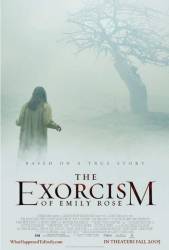Continuity mistake: When the lawyer, Laura, is in her room in two scenes, one of which is when she checks on a letter almost at the end of the film, her hair is lighter than the rest of the movie, where her hair is noticeably darker.
Continuity mistake: When Ethan Thomas submits his opening statement in the court room, Emily's mother is wearing black. When the camera cuts to father Richard Moore she's wearing a white sweater and blue shirt, then when it cuts back to Ethan she is back in black again.






Answer: You seem to have missed the point. It boils down to what Emily believed, not anything Ethan manages to explain away. In her written letter the priest reads in court she explains that she believes people would have to believe in God if she showed them the Devil. The logic goes like this: if someone sees or experiences something so horrible that they have to believe the Devil exists, then there has to be a God as well. It's about getting people to embrace faith, which was her ultimate goal. She wasn't concerned with anyone potentially finding evidence to the contrary. She believed that she had to suffer greatly and die in order to achieve the goal, which is the essence of martyrdom. Whether she suffered from mental illness or demonic possession is irrelevant in the end. Emily believed that she did her part to prove God exists when she died and that was all that mattered to her. As for her telling anyone despite her being dead, well, there were witnesses to the attacks and her story was national news. Her story would live on after her death, so in a way she'd be telling anyone that looks into her story.
dewinela